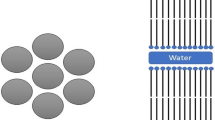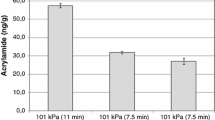Abstract
Baking powder is a critical ingredient in baked goods, but its premature reaction during baking can lead to the production of low-quality products. To address this issue, we developed a microencapsulation technique using beeswax and carnauba wax as coating materials to delay the chemical reactions of baking powder. The microcapsules were synthesized in a 1:1 ratio and their particle size distribution and efficiency were analyzed. The results showed that carnauba wax outperformed beeswax in terms of particle size and performance. Scanning electron microscope (SEM) images revealed that carnauba wax effectively coated the baking powder. Fourier-transform infrared spectroscopy (FTIR) confirmed the presence of baking powder in the structure of the microcapsules and indicated an interaction between the components. Differential scanning calorimetry thermal (DSC) analysis demonstrated that carnauba wax provided good protection to baking powder at high temperatures. Rheological analysis of carnauba wax revealed shear timing and a gradual decrease in the storage and loss modulus in all samples. An increase in the percentage of carnauba microcapsules led to an increase in tan δ. Overall, the findings suggest that carnauba wax is an effective coating material for delaying chemical reactions and CO2 release, potentially leading to improved quality of baked goods. This research has important implications for the food industry and may lead to the development of new methods to improve the quality and shelf life of baked products.








Similar content being viewed by others
References
M. Alkaloo, C. Cao, The Effect of different Leavening Agents on the volume of the produced cake. The Expedition, 12 (2021)
B. Neeharika, W.J. Suneetha, B.A. Kumari, M. Tejashree, Leavening Agents for Food Industry. Int. J. Curr. Microbiol. App Sci. 9(9), 1812–1817 (2020)
T. Godefroidt, N. Ooms, B. Pareyt, K. Brijs, J.A. Delcour, Ingredient functionality during foam-type cake making: a review. Compr. Rev. Food Sci. Food Saf. 18(5), 1550–1562 (2019)
S.M. Ojagh, S. Hasani, S. Characteristics and oxidative stability of fish oil nano-liposomes and its application in functional bread. J. Food Meas. Charact. 12(2), 1084–1092 (2018)
B. Ding, C. Li, M. Pan, Y. Chiou, Z. Li, S. Wei, & X. Yin. Microencapsulation of xanthan gum based on palm stearin/beeswax matrix as wall system. J. Food Process. Eng. 42(5), e13102 (2019)
T.A. Comunian, R. Ravanfar, S.D. Alcaine, A. Abbaspourrad, Water-in-oil-in-water emulsion obtained by glass microfluidic device for protection and heat-triggered release of natural pigments. Int. Food Res. J. 106, 945–951 (2018)
R. Ravanfar, T.A. Comunian, R. Dando, A. Abbaspourrad, A. Optimization of microcapsules shell structure to preserve labile compounds: a comparison between microfluidics and conventional homogenization method. Food Chem. 241, 460–467 (2018)
S. Haghighat-Kharazi, J.M. Milani, M.R. Kasaai, K. Khajeh, Microencapsulation of α-amylase in beeswax and its application in gluten-free bread as an anti-staling agent. Lwt 92, 73–79 (2018)
P. Gundev, K. Chauhan, D. Sachdev, T.L. Swer, Formulation and characterization of butylated hydroxytoluene (BHT) microspheres using natural beeswax as encapsulating material. J. Food Process. Preserv. (2022)
T.T.B. De Medeiros, A.M. de Azevedo Silva, A.L. da Silva, L.R. Bezerra, D.L. da Silva Agostini, D.L.V. de Oliveira, R.L. Oliveira, Carnauba wax as a wall material for urea microencapsulation. J. Sci. Food Agric. 99(3), 1078–1087 (2019)
A. Nandy, R. Saremi, E. Lee, S. Sharma, Stability and applicability of retinyl palmitate loaded beeswax microcapsules for cosmetic use. Johns. Matthey Technol. Rev (2022)
I.J. Joye, G. Davidov-Pardo, D.J. McClements, Encapsulation of resveratrol in biopolymer particles produced using liquid antisolvent precipitation. Part 2: Stability and functionality. Food Hydrocoll. 49, 127–134 (2015)
R.P. Lahiji, M. Mohammadi, M. Moslemy, P. Aminigram, Effect of shortening type on the rheological characteristics of cookie dough. Archives of Advances in Biosciences, 4 (2013)
U. Klinkesorn, P. Sophanodora, P. Chinachoti, E.A. Decker, D.J. McClements, Characterization of spray-dried tuna oil emulsified in two-layered interfacial membranes prepared using electrostatic layer-by-layer deposition. Int. Food Res. J. 39(4), 449–457 (2006)
A. Joelson Netto, Microesferas de cera de carnaúba contendo ureia na dieta de ovinos: obtenção, caracterização, consumo, digestibilidade e perfil metabólico. (2018)
M. Ahmad, B. Ashraf, A. Gani, A. Gani, Microencapsulation of saffron anthocyanins using β glucan and β cyclodextrin: Microcapsule characterization, release behaviour & antioxidant potential during in-vitro digestion. Int. J. Biol. Macromol. 109, 435–442 (2018)
C.C. Chu, Z.A.B.A. Hasan, Chua, & K. L. Nyam. Formulation and characterization of novel nanostructured lipid carriers with photoprotective properties made from carnauba wax, beeswax, pumpkin seed oil, and UV filters. J. Am. Oil Chem. Soc 97(5), 531–542 (2020)
L.L.S. Borba, M.F.D. Oliveira, M.A.F. Melo, D.M.A. Melo, S.B.C. Pergher, Preparation of adsorbents from natural materials hydrophobized with carnauba wax. Revista Perspectiva 37, 37–46 (2013)
D. Stojaković, B. Bugarski, N. Rajić, A kinetic study of the release of vanillin encapsulated in carnauba wax microcapsules. J. Food Eng. 109(3), 640–642 (2012)
L. Svečnjak, G. Baranović, M. Vinceković, S. Prđun, D. Bubalo, & I. Tlak Gajger. An approach for routine analytical detection of beeswax adulteration using FTIR-ATR spectroscopy. (2015)
I.M. Demiate, N. Dupuy, J.P. Huvenne, M.P. Cereda, G. Wosiacki, Relationship between baking behavior of modified cassava starches and starch chemical structure determined by FTIR spectroscopy. Carbohydr. Polym. 42(2), 149–158 (2000)
D.G. Conceição, B.H.R. Gonçalves, F.F.D. Hora, A.S. Faleiro, L.S. Santos, S.P. Ferrão, Use of FTIR-ATR spectroscopy combined with multivariate analysis as a screening tool to identify adulterants in raw milk. J. Braz Chem. Soc. 30, 780–785 (2019)
W.F. Tinto, T.O. Elufioye, J. Roach, Waxes. Pharmacognosy. Academic Press, pp. 443–455 (2017)
T.C. Keener, G.C. Frazier, W.T. Davis, Thermal decomposition of sodium bicarbonate. Chem. Eng. Commun. 33(1–4), 93–105 (1985)
F.W. McLafferty, D.B. Stauffer, The Wiley/NBS Registry of mass Spectral data (Wiley, New York, 1989), p. 1
J. Milanovic, V. Manojlovic, S. Levic, N. Rajic, V. Nedovic, B. Bugarski, Microencapsulation of flavors in carnauba wax. Sensors 10(1), 901–912 (2010)
G. Carullo, F. Scarpelli, E. L. Belsito, P. Caputo, C. Oliviero Rossi, A. Mincione, A. Crispini, A. Leggio, D. Restuccia, UG, Spizzirri & F. Aiello. Formulation of new baking (+)-catechin based leavening agents: Effects on rheology, sensory and antioxidant features during muffin preparation. Foods, 9(11), 1569 (2020).
J. Lim, S. Jeong, & S. Lee. Evaluation of soybean oil-carnauba wax oleogels as an alternative to high saturated fat frying media for instant fried noodles. LWT, 84, 788-794 (2017).
D. Thakur, A. Singh, P. K. Prabhakar, M. Meghwal, & A. Upadhyay, Optimization and characterization of soybean oil-carnauba wax Oleogel. LWT, 113108 (2022).
Author information
Authors and Affiliations
Corresponding author
Additional information
Publisher’s Note
Springer Nature remains neutral with regard to jurisdictional claims in published maps and institutional affiliations.
Rights and permissions
Springer Nature or its licensor (e.g. a society or other partner) holds exclusive rights to this article under a publishing agreement with the author(s) or other rightsholder(s); author self-archiving of the accepted manuscript version of this article is solely governed by the terms of such publishing agreement and applicable law.
About this article
Cite this article
Khosronia, A., Asadi, G., Jafarpour, A. et al. Feasibility of encapsulation of baking powder with carnauba and beeswax and investigating the physicochemical properties of produced powder. Food Measure 17, 5163–5174 (2023). https://doi.org/10.1007/s11694-023-01944-2
Received:
Accepted:
Published:
Issue Date:
DOI: https://doi.org/10.1007/s11694-023-01944-2




